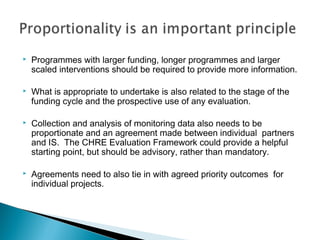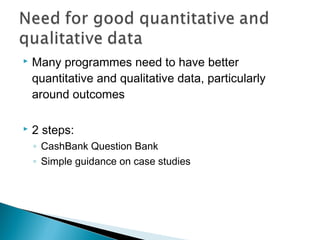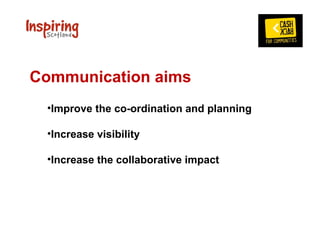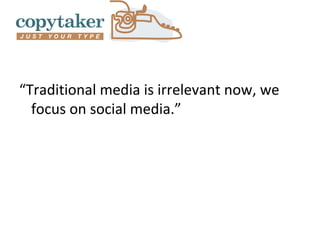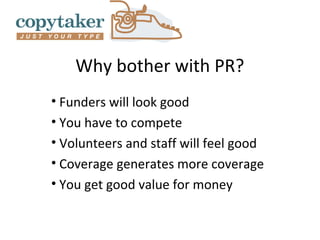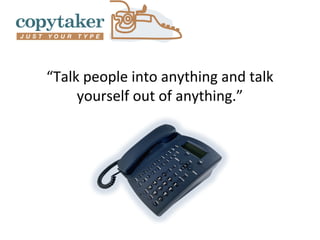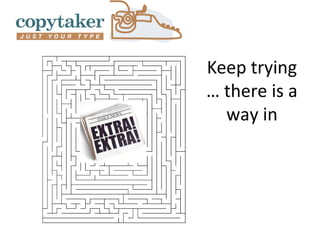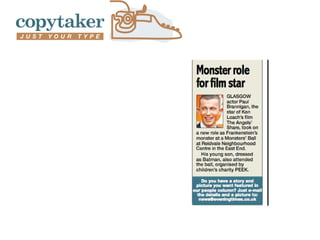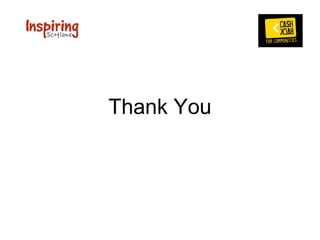Cashback Portfolio day presentation - October 2012
- 1. Welcome
- 2. 10:00 Welcome - Actions since August 10:30 Summary of key findings from the evaluation meetings with CashBack partners 11:30 Tea & coffee 11:45 Refining the logic model/outcome framework and methodological support for evaluation 12:30 Lunch 13:30 Communication Andrea Pearson – Copytakers Andrea is a journalist providing an insight into what journalists look for, how to write effective press releases & documents 14:45 Tea & coffee 15:00 Questions and Answers 15:30 Close
- 4. IMPACT and EVALUATION Points Raised Actions Lack of clarity on requirements 1-2-1 meetings with PA’s Framework and definition of outcomes PA’s support Evaluation audit with RfR Support on expressing outcomes On going support and training cross portfolio
- 5. COMMUNICATION Points Raised Actions Who is who – and what do they do? Portfolio day Who’s who guide Profile raising and effective communication Comm’s Group Co-ordinated approach re-defining messages Social media
- 6. SUSTAINABILITY Points Raised Actions Alternative funding sources/engage 1-2-1 support from PA’s with the private sector Grouping together/maximise portfolio Networking and PA’s
- 8. Cathy Sharp and Mark Bitel 30 Oct 2012
- 9. CashBack is a diverse portfolio of interventions. There is a need to agree outcomes, including priorities. ◦ There is no overall ‘logic model’ for the CashBack programme ◦ Frequent confusion between outputs and outcomes ◦ Some logic models not linked through to evaluation plans and data sources
- 10. Impact – the intended longer term or structural changes Outcome – The differences or changes as a result of what the organisation or programme has done. Output – this describes what the organisation or programme does Input – Resources put into the work to achieve objectives and aims. (e.g. money, practical resources, staff or volunteer time)
- 11. ISSUESTATEMENT: Young people, families and other community members can benefit from engagement in positive activities that develop their interests and skills. Those living in challenging and difficult circumstances may have limited opportunities to be involved in positive activities in their communities. They may be at a higher risk of becoming involved in the criminal justice system. Anti-social behaviour, violence and crime particularly affects the life chances of those living in the most deprived communities. It is expected that such behaviours and their wider effects can be both prevented and tackled through the provision of various sporting, cultural, educational, developmental and social activities. PROGRAMME GOAL(S): To expand the horizons of young people, families and other community members and increase opportunities to develop interests and skills in enjoyable, fulfilling and supportive ways, though sporting, cultural, educational, developmental and social activities.
- 12. ‘Menu’ of generic outcomes – short term and intermediate. CB partners and IS could use this to agree a minimum/maximum number of priority outcomes (eg. 3-6) that are appropriate for each intervention, with timescales and clear links to data and priorities for data collection.
- 13. Programmes with larger funding, longer programmes and larger scaled interventions should be required to provide more information. What is appropriate to undertake is also related to the stage of the funding cycle and the prospective use of any evaluation. Collection and analysis of monitoring data also needs to be proportionate and an agreement made between individual partners and IS. The CHRE Evaluation Framework could provide a helpful starting point, but should be advisory, rather than mandatory. Agreements need to also tie in with agreed priority outcomes for individual projects.
- 14. Many programmes need to have better quantitative and qualitative data, particularly around outcomes 2 steps: ◦ CashBank Question Bank ◦ Simple guidance on case studies
- 15. This is frequently missing or subdued and is linked to the relative lack of outcome data. Better case studies would help to address this. There is a need for guidance on innovative/fun ways to get feedback from YP and others at regular intervals.
- 16. Self-evaluation can support learning and the management and improvement of the delivery of projects. ◦ What’s working well? What’s not? What do we need to do differently? 5% funding rule not necessarily helpful given variations in scale of projects and split with ‘marketing’. Role of external evaluation not always clear.
- 17. Encourages organisations to develop the use of evaluation logic and skills to develop and enhance their practice and show the difference they are making Better use of data increases motivation among delivery organisations to help develop more effective interventions Builds reflection into practice in order to create a learning organisation Evaluation is done by organisations themselves rather than being done to organisations – specialist external support may be used. It increases ownership of findings and responsibility to act on them back into the hands of delivery organisations.
- 18. The collection and analysis of equalities monitoring data is frequently weak. Inspiring Scotland should agree the appropriate breadth and depth of monitoring of equalities
- 19. The scoping and delivery of a future impact evaluation of the programme would be assisted by the production of a digest of funded projects with brief details of each funded intervention/sub- programme. This should be collated to a standard, short (2 page?) format and include the agreed outcomes.
- 20. Assessing Progression Eg. minor adjustments and simple recording conventions could yield more data on progression eg. membership renewals/retention/progression. Health warnings eg. attribution – value of local intelligence /qualitative data
- 21. Lunch !
- 22. Communications or Its good to talk!
- 23. Effective Evaluation can be. . . . • A tool for business development • A tool for raising funds • A tool for raising your profile
- 24. COMMUNICATIONS Points Raised Actions who is who – and what do they do? Portfolio day Who’s who guide profile raising /effective communication Comms Group Co-ordinated approach Defining ‘messages’ Social media
- 25. Communication aims •Improve the co-ordination and planning •Increase visibility •Increase the collaborative impact
- 26. Sept – Oct over 80 pieces of news generated
- 28. Where we are... • Who is Who booklet – draft 1 • Communications Group – meeting 1 •Media planner – Quarterly •Ministerial visit’s identified Next Steps... •Social media •Monthly up-dates/newsletter •Building the collective story •Visual map of activities
- 29. Your Task – Get Connected
- 30. Getting coverage Andrea Pearson Media relations coach
- 31. Telling your stories Andrea Pearson Many hats in journalism and PR
- 32. “I tried telling the papers about my story but they were not interested. It was waste of time.”
- 33. “Journalists are only interested in negative stories and scandal.”
- 34. “Traditional media is irrelevant now, we focus on social media.”
- 36. Why bother with PR? • Funders will look good • You have to compete • Volunteers and staff will feel good • Coverage generates more coverage • You get good value for money
- 37. Advertising Value Equivalent 30 seconds on Scottish TV news AVE £5000 Quarter page in The Herald AVE £2500 Quarter column Evening Times AVE £250 600 words in Third Force News AVE £250
- 38. Reach BBC Radio Scotland Newsdrive 900,000 The Herald 44,000 Evening Times 50,000 Third Force News 16,000
- 39. • The only two things you need to do are: • Talk to the right people • Present the story well
- 40. Talking to the right people • Monitor coverage to find out who writes about this and talk to them • Or target a specific publication or outlet and find out who is the relevant person to speak to
- 41. Weave yourself into the news process
- 42. Build up your personal contacts
- 43. Present the story well: The P and R of PR • P Pictures • R Real people
- 44. • P Pictures
- 45. Halloween dog costume parade 2012
- 46. Irn-Bru Makers AG Barr 'Proud' To Sign-Up As Official Supporter Of Glasgow 2014
- 47. • New approach to PE proves a big hit at Capital primary
- 52. • R Real people
- 53. Only people can express opinions They give credibility to your work They engage with audiences Only they can prove you are changing lives
- 55. The magic PR formula • Before (project) my life was (not good) now it is (better)
- 56. Make journalist’s job easier Accurate information Things written down Essential details Your email, landline and mobile number
- 57. • “Always on the go!”
- 58. “There is lots of typing”
- 59. “Talk people into anything and talk yourself out of anything.”
- 60. • My story did not get coverage … I probably did not speak to the right person or present the story very well
- 61. Keep trying … there is a way in
- 62. • (no subject) • • Hi Gordon, Please see attached press release, please let me know if you can use any of it for your Community Column
- 65. Questions?
- 66. Thank You
Editor's Notes
- 10 am Introductions What you asked for last time? 10.30 am Evaluation – a Logic Model? 11.30 am Refreshments 11.45 am Evaluation – Data requirements 12.30 pm Lunch 1.30 pm Communications – its good to talk 3.10 pm Questions and Answers 3.30 pm Depart
- Celia’s slides Understanding Impact / Evaluation This will be the morning session kindly being operated by Cathy Sharp and Mark Bitel of Research for Real – who the majority of you have now met Communications In relation to actions from the last portfolio day and needs expresses by many of the partners in the room - this will be the afternoon session Sustainability – for another day – aktouugh both Evualationa dn Profikle raising contribuet to this
- Celia’s Slide 11 weeks to the day since the last/first portfolio day! Time flies when you are having fun! at that meeting you requested we deliver for you on a number of items pamphlet completed – completed
- These are headline demonstrating what the day will entail – we will hear more about each sector as we go on
- Not as heavily investigated as yet as more detail on this area needs to be collated by all, and to effectively look to the future you need to understand what you business MAY be doing in the future – hence understanding demand and strength of your services BY EFFECTIVE EVALUATION Leads to – introduction to Cathy and Mark – the sessions that will take us through this morning Celia – can you do an introduction as to who they are and why they are involved please.
- Our task has been diagnostic – to take the temperature about where CashBack partners are at now with their monitoring and evaluation activities. This was commissioned with a view to informing the overall CashBack programme evaluation. This needs to be built from the ‘bottom-up’ – by ensuring that all projects have good monitoring data and quality case studies that address agreed outcomes. We want to see much greater valuing of evaluation. We recognise the existence of the CHRE framework. We wish to take a pragmatic and simple view to avoid investing time into activities with little practical value and risk re-producing earlier guidance.
- We should not expect everyone to be doing the same thing or retro-fitting agreed activities into an inappropriate outcome framework. Any guidance must remain aware of ‘outlier’ projects that may not easily fit into the generic picture. Many delivery agents have never had a conversation with the previous CashBack team about outcomes. A pressing need is for projects to agree clear outcomes for their work with Inspiring Scotland.
- In the search for programmatic coherence we did test out with you the idea of an overall ‘logic model’. We’re interested in knowing your views about the overall ‘issue statement’ and programme goals. Each CB partner should be able to see their work within that overall purpose. We think the current text version of the logic model is sufficient for the current purposes. Logic models are most useful in the planning stage of interventions and it may be worth developing one for the next stage of CashBack. We are not in the planning stage now. Let’s acknowledge that projects some have logic models and some have used these to help their thinking about delivery. Others have logic models that are not followed through into delivery, subsequent evaluation plans or data sources. Investing time in developing bespoke individual logic models runs the risk that we would be no further forward in practical terms.
- Rather we propose a better option is to develop an Outcomes Framework Will look at this idea in more detail after the break
- It might be useful to develop a bank of questions to help address missing outcome data. These could be used in a number of ways, and would help to bring some alignment and consistency of data between similar activities that are being delivered to achieve similar outcomes. Developing such a ‘bank’ should be done in collaboration with the Cashback family so that they assist in drafting, testing and revision. There is a need for better qualitative data that is outcome focused . Much of what exists is seen as primarily for marketing/publicity purposes. Better qualitative data can also help to understand attribution better. A ‘formula’ for writing outcome focused case studies would assist projects to structure a variety of case studies. This might also address frequently asked questions about case studies?
- At present, evaluation is often too closely aligned with ‘marketing’ or publicity/good news. Some projects have expressed doubt about data quality because of reluctance to be seen to be critical in case funding is threatened. A stronger focus on learning and the value of evaluation for continuous improvement is needed to enable discussions about what’s not working well (as well as what is) and get better regular feedback from project participants. The role of external evaluation needs to be discussed, including timing, purposes, readiness and funding. The 5% rule needs review given the variation in scale and funding of projects within the overall programme. We would like to suggest that the CHRE framework should be seen as advisory.
- eg. formal memberships organisations should collect deeper level of equalities data that is sensible for the context and their purpose.
- Rachel and Eilidh’s area Rachel – to lead off. . . .
- Reflect on why evaluation is important – it covers more than the reports to SG! Business development – meeting clients needs, getting services right, stopping services that aren’t working – remodelling and adjusting as to what needs are demonstrated Raising funds – most funders seek logic models – but also evidence of how you work to gather funding – from BIG to CiN, from Local Authorities to Trusts – outcome analysis is becoming more the ‘norm’ – so don’t miss the boat A good story is compelling good evidence is compelling so why not evaluate effectively? if the stories are good – tell more? More people might be interested? More people may access you through wider means? its so much cheaper than the days of paid adverts! Stress this element Remind what key Comms issues came out from the last portfolio day – the issues raised are – following slide
- The CashBack for Communities programme partners have to-date been very successful in communicating with the target audience of young people across Scotland about the range of activities available to them in their area. They have generated a wide and diverse range of good news stories over five years of the programme and 99% of media coverage generated to-date is positive. Getting the wider message out to the general public and other relevant stakeholders about what CB for Communities does, the success it is having and the impact is it making on local communities across Scotland has also been good, but is an area to be further developed and one we seek to support. To raise awareness and promote greater understanding of the range and depth of work CashBack funds, we have indentified the follow areas to focus support: Raise the visual profile of CB as a collective. Improve partners ability to demonstrate the impact of CB activities. Improve the dissemination of the collaborative impact of CB at a national level. Support CB partners to be more co-ordinated and strategic in their communication Identify key stakeholders relevant to CB Three main areas Improve the co-ordination and planning of CB programme Increase visibility of CB activities Increase the collaborative impact of CB
- Who is Who – given out earlier as a tool to network with, to review, to see where there is synergies and benefits of working together Portfolio day – regular events when you and your team can come along to the day – putting names to faces always helps Comms Group Started based on feedback from last portfolio day For all partners, great to have member of communications team Plan to have one meeting a quarter, for some reflection, some training if needed, forward planning but also to help build the collective CashBack story. What’s it for? planning ahead clear messaging support / involvement from Scottish Government
- My impressions of PR are that you are always moving around, dealing with new people and always on the go.
- In PR there is lots of finding information, then typing it and then adding to your information, then typing it and then sorting out your story then typing it and eventually finalising your story, then typing it. In conclusion there is lots of typing.
- When working in PR you have to be able to communicate well with people, talk people into anything and talk yourself out of anything.













